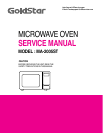
- 14 -
3-2. Conventional heating vs. dielectric heating
1. Conventional heating
* The heat energy from the sources of the heating power shall be transmitted
from the warm surface to the cold inside.
* Heating with the strong fire: The surface of the food shall be well done, but be
burnt to have a black side, and the center of the food shall not be well-done.
* Heating with the weak fire: The surface of the food shall be burnt and have a
little black side, but it shall be taken lots of time for the center to be well-done.
* The thermal conductivity in the water or in the food is low.
2. Dielectric heating
1) The heating is uniform.
2) The temperature rise is fast (high).
3) If you break the electric power: The microwave oven stops
heating at once, so you can’t heat something with the heat
of their surroundings.
4) Since it heats inside, the surface isn’t damaged.
* The water, the oil and the foods shall absorb the electric wave well.
* It generates heat all around the apparatus and the foods are well-done
with short time
* If you heat something for long time, all of it will be burnt and can’t be eaten.
FIRE!
FIRE!
FIRE!
FIRE!
FIRE!
FIRE!
FIRE!
FIRE!
FIRE!
FIRE!
FIRE!
FIRE!
FIRE!
FIRE!
HEAT!
HEAT!
HEAT!
HEAT!
HEAT!
HEAT!
HEAT!
HEAT!
HEAT!
HEAT!
HEAT!
HEAT!
HEAT!
HEAT!
FOOD!
TRANSMITTED!
BY CONDUCTION!
It shall be heated by the sources of the electric heater, the gas, and the briquet.!
WELL-DONE!
HALF-DONE!
UNDER!
DONE!
WAVE
WAVE
WAVE
WAVE
WAVE
WAVE
WAVE
WAVE
WAVE
WAVE
WAVE
WAVE
WAVE
MOLECULES
FOOD
• If you give microwave to food with the microwave oven, the food and
molecules of the water included in the food is turned, or moved and generates
heat with the friction among the the molecules.


















